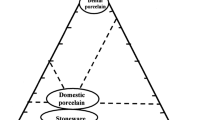Abstract
The reasons for the modification of the structure and properties of porcelain mixtures subjected to maturing are analyzed in the context of laws governing of the evolution of microbial communities. It is shown that introduction of a nutrient substrate to a porcelain mixture stimulates the activity of natural microflora which is accompanied by favorable modification of the coagulation and condensation structure. The sintering process is concurrently intensified and the degree of “ripening” of porcelain is increased.
Similar content being viewed by others
References
E. V. Saiko, “History of ceramic trade technology,”Dokl. RASKhN, No. 2, 19–22 (1994).
V. A. Kind and S. D. Okorokov,Construction Materials: Production, Properties, and Application [in Russian], Gosstroiizdat, Moscow — Leningrad (1934).
F. S. Entelis, “Texturization of plastic ceramic mixtures,”Steklo Keram., No. 6, 26–28 (1975).
A. S. Vlasov, “Biological methods for concentration of mineral materials and technological mixtures in ceramic production,” in:Chemistry and Technology of Silicate and High-Melting Nonmetallic Materials [in Russian], Leningrad (1989).
S. N. Vainberg, “The effect of silicate bacteria on the composition and properties of ceramic materials,”Author’s Abstract of Candidate’s Thesis [in Russian], Moscow (1983).
A. N. Chernyshov, “The effect of biological treatment of mixtures on technological properties of porcelain,”Author’s Abstract of Candidate’s Thesis [in Russian], Moscow (1960).
G. Bertelin, “Microbiological extraction of metals from rocks,” in:Biogeotechnology of Metals [in Russian], Moscow (1985).
Z. A. Avakyan, “Microflora of rocks and its role in leaching of silicate minerals,”Biogeotechnology of Metals [in Russian], Moscow (1985).
T. V. Aristovskaya,Microbiology of Soil Formation Processes [in Russian], Nauka, Leningrad (1980).
I. N. Antipov-Karataev and I. G. Tsuryupa. “Regularities of biochemical decomposition of albite and muscavite,”Kora Vyvetrivaniya, No. 7, 110 (1966).
V. G. Aleksandrov and G. A. Zak, “Bacteria destroying aluminosilicates,”Mikrobiologiya,19(2), 97 (1950).
K. I. Surman, “On soil bacteria close to speciesB. mucilaginosus n. sp.,”Author’s Abstract of Candidate’s Thesis [in Russian], Leningrad (1962).
Z. A. Avakyan, T. A. Pivovarova, and G. I. Karavaiko, “Characteristics of the new speciesB. mucilaginosus,”Mikrobiologiya,55(3), 477–482 (1986).
E. S. Shelobolina, Z. A. Avakyan, G. I. Karavaiko, et al., “Description of the new species of mucus-forming bacteriaBacillus edaphicus sp. nov. and confirmation of the taxonomic status ofBacillus mucilaginosus using data of phenotypic and genotypic analysis,”Mikrobiologiya,66(6), 813–822 (1997).
L. V. Ogurtsova, Z. A. Avakyan, and G. I. Karavaiko, “Growth ofB. mucilaginosus in heterotrophic and autotrophic conditions,”Mikrobiologiya,60(5), 823–827 (1991).
D. H. Mortel, “Veranderungen von Rohstoffelgenschaften durch bacteriellen und myconischen,” in:Forschungsberichte der DKG: Research Reports of the German Ceramics Society (1986–1987), pp. 211–220.
V. Verges and B. Valat, “Contribution a l’etudedu viesillisement des argiles — Contribution to the investigation into the Maturing of Clay,”L’industrie Ceramique, Dart 1, No. 808, 574–576 (1986).
S. Basu and S. Bahdyopadhyay, “Chemical Decolorization of China Clay. A Review,”Indian Ceram.,24 (5), 95–97 (1981).
G. A. Dubinina and V. V. Balashova, “Microorganisms participating in circulation of iron and manganese amd their use in hydrometallurgy,” in:Biogeotechnology of Metals [in Russian], Moscow (1985).
D. R. Lovley, “Dissimilatory Fe(III) and Mn(IV) Reduction,”Rev. Microbiol.,55, 259–287 (1991).
S. I. Kuznetsov and G. A. Dubinina,Methods for Studying Water Microorganisms [in Russian], Nauka, Leningrad (1963).
G. N. Maslennikova, Yu. T. Platov, and R. A. Khalillulova, “Whiteness of porcelain,”Steklo Keram., No. 2, 13–19 (1994).
L. P. Karpilovskii and A. A. Tuzhikov, “Improvement of methods for monitoring ceramic suspension,”Steklo Keram. No. 2, 28–29 (1976).
G. N. Maslennikova, R. A. Khalillulova, and Yu. T. Platov, Identification of ferric compounds in clay-containing materials,”Steklo Keram., No. 2, 12–15 (1999).
Yu. T. Platov, “Whiteness of porcelain: Nature, estimation, and ways for improvement,”Author’s Abstract of Doctoral Thesis [in Russian], Moscow (1995).
R. A. Khalilullova, “Improvement of porcelain whiteness using complex treatment of mineral material,”Author’s Abstract of Candidate’s Thesis [in Russian], Moscow (1994).
E. S. Turova and G. A. Osipov, “A study of the structure of microbic community active in biotransformation of ferric minerals in kaolin,”Mikrobiologiya,65, 681–689 (1996).
E. S. Turova, Z. A. Avakyan, and G. I. Karavaiko, “The role of bacterial community in transformation of ferric minerals in kaolin,”Mikrobiologiya,65(6), 837–843 (1996).
G. N. Maslennikova and Yu. T. Platov, “The process of porcelain formation in the presence of additives,”Steklo Keram. No. 2, 19–24 (1998).
Yu. T. Platov, R. A. Khalilullova, and G. N. Maslennikova, “Improvement of light-diffusing capacity of porcelain,” Keramich. Prom., Nos. 3–4, 9–14 (1993).
W. D. Kingery,Introduction to Ceramics [Russian translation], Stroiizdat, Leningrad (1967).
Author information
Authors and Affiliations
Additional information
Translated from STeklo i Keramika, No. 10, pp. 15 – 23, October, 1999.
Rights and permissions
About this article
Cite this article
Maslennikova, G.N., Platov, Y.T., Khalilullova, R.A. et al. The effect of microorganisms on the properties of porcelain mixtures in maturing (a review). Glass Ceram 56, 312–319 (1999). https://doi.org/10.1007/BF02681385
Issue Date:
DOI: https://doi.org/10.1007/BF02681385




